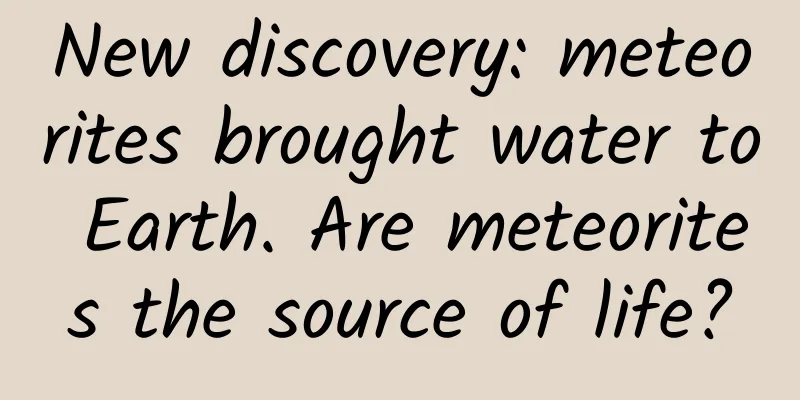New discovery: meteorites brought water to Earth. Are meteorites the source of life?

|
Scientists discover liquid water in meteorites, clues dating back to the early solar system On April 24, 2012, one night two days after a spring chill, an iron meteorite collected by Peter Ginesken, a meteor astronomer at NASA's Ames Institute for Extraterrestrial Intelligence, fell in Sant. Research in 2021 showed that researchers found liquid water in meteorites. (Image courtesy of NASA James) Scientists have discovered water in early meteorites, expanding our knowledge of the ancient solar system. Water is abundant in our solar system. For example, there is liquid water on Saturn's moon Enceladus, and water has also been detected on Mars. Outside the Earth, the existence of water is well known. Therefore, scientists suspect that a type of meteorite called carbonaceous chondrite also contains water, but they have never found liquid water so far. In a new study, researchers have detected a meteorite from the early solar system that contained liquid water rich in carbon dioxide. The new mission could expand our understanding of planetary evolution and how meteorite water came to Earth long ago. "The discovery of water in cosmic rocks gives us direct evidence of the fantastic evolution of our solar system," Ritsumeikan University professor Kawasaki Yamaaki told the Space.com website via email. In the new study, researchers have been detecting the presence of water in the Mir meteorite. (Yamaaki Kawasaki, Science Advances 2021) Kawasaki and colleagues looked closely at the Mir meteorite, which was formed about 4.6 million years ago and fell to Earth in 2012. Many fragments were found near the Sante Mir gold mine in Sacramento, California. Using microscopy techniques to examine the fragments, they noticed that some tiny calcite crystals contained even smaller liquids (probably nanoscale) containing 15% carbon dioxide. This discovery confirms that liquid water and carbon dioxide existed in the ancient universe. "Our activity shows that our team has detected traces of water in a 4.6 million year old mineral." Kawasaki Yamaaki said in a statement. Researchers think the parent bodies of smaller space rocks may have been made of ice and carbon dioxide, meaning they came from a cooler part of the solar system (probably away from Jupiter's orbit) and eventually fell to Earth. Previous theories suggest that asteroids are rich in water molecules and formed when they were far from the solar system before approaching the sun. The researchers also believe that this discovery can help uncover the origin of Earth's water. There are many theories about where and how Earth got its water. One of the leading theories is that water was trapped in objects such as meteorites (especially carbonaceous chondrites) and brought to Earth. According to this theory, water molecules encapsulated in calcite structures may be the source of Earth's water, Kawasaki said. Today, “discoveries of large amounts of liquid water are rare,” Kawasaki said, but this study “shows evidence that there is liquid water.” In other words, they added. "If the water of the earth is formed by the water of these minerals, then is it the "mother water" of the earth's water? Meteorites carry these minerals, and can also be called the "grandparent minerals" of the earth's water." Related knowledge The Solar System is a system of stars bound together by the Sun's gravity. It consists of the Sun and the celestial bodies that orbit it directly or indirectly. Of the celestial bodies that orbit the Sun directly, the eight largest are called planets, while the rest are much smaller than planets, such as dwarf planets, asteroids, and comets. The celestial bodies that orbit the Sun indirectly are called satellites, two of which are larger than the smallest planet, Mercury. A meteorite is a solid fragment of an object that originated in outer space and has fallen to Earth, such as a comet, asteroid, or meteoroid. It is what remains after passing through the atmosphere to reach the surface of a solid planet or satellite. When the original object enters the atmosphere, factors such as friction, pressure, and chemical interactions with atmospheric gases cause it to heat up and radiate energy. It then becomes a meteor (also called a shooting star or falling star), a fireball, a shooting star, or a falling star. Astronomers call the brightest examples of meteors that collide with Earth "bolides". Meteors such as fireballs eventually impact the Earth's surface anyway. [1][2] Meteorites have an impact on the Earth's surface and life, and range in size from small to extremely large. Meteorites have also been found on Mars.[3] BY: Chelsea Gohd FY: Xu Zili If there is any infringement of related content, please contact the author to delete it after the work is published. Please obtain authorization for reprinting, and pay attention to maintaining integrity and indicating the source |
>>: Be careful! If you build a house here, it will "run away" by itself
Recommend
Can my iPhone X last another 3 years?
Whether you buy an iPhone 11 or an iPhone X, the ...
What is the difference between working in an Internet company and a software company?
[[128823]] My daily job is to help programmers ch...
Amap launches new feature: mobile phone becomes car navigation remote control
Are you still struggling to decide whether to use...
Want to do a "screen-sweeping" marketing? Understand user psychology first!
There is perhaps no industry in the world that is...
Four marketing steps that must be initiated before the APP is launched
Nowadays, making an APP is a very simple thing, b...
What are the "Fermi Paradox" and the Great Filter Hypothesis? Does the cosmic civilization filter really exist?
After the "Fermi Paradox" about aliens ...
Sogou advertising promotion, Sogou advertising account opening fee
Sogou Search has many search platforms, such as S...
Where does our "body odor" come from? Eating habits can actually change body odor
Did you know that we humans do not rely on vision...
Mobile phone manufacturers become OEMs: not decline but another way out
Lenovo has just denied the news of returning to O...
Artifact recommendation! 10 niche, easy-to-use and high-end operation tools!
It is said that if the underwear is well chosen, ...
Fanstong operation experience—original and practical information! (Analyze usage scenarios, increase user density, and be creative)
During the operation process, great emphasis is p...
98k《Taote no-source e-commerce project》From entry to mastery
Training course content: Experienced operators an...
100,000 units sold! DeepBlue enters a new journey, once again proving its super-range extended-range technology
14 months, 100,000 vehicles! On September 22, Dee...
How Apple quietly changed the Personal Hotspot feature in iOS 13.1
If you often use the personal hotspot feature on ...
Wuwei Investment Forum: How to Find a Good and Competitive Company
Wuwei Investment Forum "How to Find a Good C...









